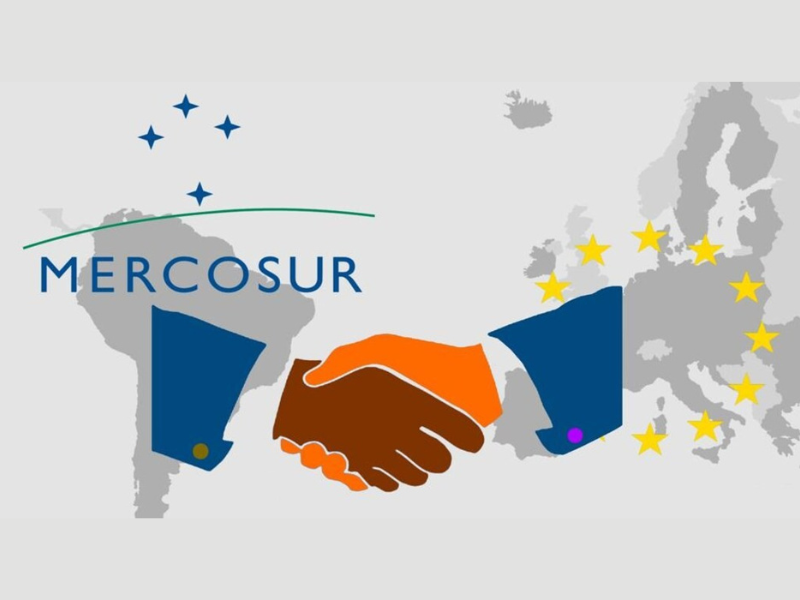Beyond Tariffs: The New U.S.-EU Framework Agreement
Published by Veronica Campostrini. .
Importexport Europe Trade war Free trade agreements United States of America Foreign marketsAugust 21, 2025 – After a period of trade tensions, regulatory skirmishes, and threats of tariff wars, the United States and the European Union have chosen the path of cooperation. With the signing of the Framework Agreement, Washington and Brussels are aiming for something far more ambitious than a simple trade deal: a strategic roadmap to consolidate an economic-industrial bloc capable of setting global standards. It’s not just a matter of tariffs. The agreement outlines a long-term plan designed to strengthen the combined competitiveness of both sides of the Atlantic, which together account for nearly half of the world’s GDP. In the background looms an increasingly fierce competition with Beijing, New Delhi, and other “non-aligned” actors.
A Narrower Atlantic
The first tangible impact of the agreement will be seen on the trade front, but the mechanism is less straightforward than it appears. Starting from September 1, 2025, Washington will simplify customs regulations for high-tech-intensive sectors — aerospace, pharmaceuticals, chemicals, and natural resources — applying only Most Favored Nation (MFN) tariffs and eliminating all additional duties.
Brussels, on the other hand, will eliminate tariffs on all U.S. industrial products and open preferential lanes for numerous agricultural and fishery products, including nuts, dairy, pork and bison meat, soybean oil, and even processed lobster.
For other European goods, the United States sets a maximum cap on import tariffs at 15%, with the exception of a list of exempt products. Since a final document is not yet available, it is reasonable to assume that the list will remain the same as the one already published when the reciprocal tariffs were introduced on April 2, known as “Annex II.”
However, a legal hurdle remains. The EU’s elimination of tariffs appears to apply only to U.S. products; yet under WTO rules, if Brussels zeroes out MFN tariffs for the U.S., it should extend the same treatment to all members — unless the measure falls under a notified free trade agreement. Since the Framework Agreement is not a full FTA, the most likely interpretation is that the EU will rely on a WTO-compatible exception to keep the benefit limited to the United States.
The stated goal is ambitious: to make trade flows smoother and strengthen the competitiveness of SMEs on both sides of the Atlantic.
Energy and Technology: The Strategic Axis of the 21st Century
While physical goods will move only partially freely, the true scope of the agreement lies mainly in energy, semiconductors, and artificial intelligence.
The European Union commits to purchasing liquefied natural gas, oil, and nuclear products from the United States for a total value of $750 billion by 2028. The move aims to diversify energy supplies and reduce dependence on markets considered “non-aligned.”
On the technology front, Brussels plans to spend $40 billion on U.S.-made artificial intelligence chips to boost the computing power of European data centers.
Automotive, Steel, and Aluminum: Easing Long-Standing Tensions
The agreement also touches on sectors that have long been sources of friction.
The United States will waive tariffs under Section 232 of the Trade Expansion Act of 1962 on European automobiles with an MFN tariff rate equal to or above 15%. For vehicles with an MFN tariff rate below that threshold, Washington will still apply a maximum overall levy of 15% (including the MFN rate and any additional duties).
For steel and aluminum, Washington and Brussels are considering tariff quota mechanisms to avoid global overcapacity and protect the resilience of supply chains. However, the 50% tariffs remain in place, with the possibility of future revisions but no deadlines set.
A Transatlantic Digital Market
The Framework Agreement is not just about physical goods: digital trade also plays a central role.
The moratorium on tariffs for electronic transmissions is confirmed, strengthening the joint commitment against new protectionist barriers. In addition, the United States and the European Union plan to develop a mutual recognition agreement on cybersecurity and work toward a progressive alignment of technological standards.
Sustainability: Reducing Hidden Barriers
Sustainability remains a sensitive and potentially divisive issue. The Framework Agreement seeks to balance environmental goals with trade fluidity:
- On the CSDDD (corporate sustainability due diligence) and CSRD (sustainability reporting) directives, Brussels promises to streamline obligations to prevent them from becoming hidden trade barriers.
- Regarding the CBAM — the carbon border adjustment mechanism — the EU will introduce greater flexibility for U.S. SMEs.
- Finally, Brussels acknowledges that U.S. production poses a negligible deforestation risk, reducing potential regulatory frictions.
Capital, Defense, and Industry
The deal also carries strong financial and industrial dimensions. By 2028, European companies will invest $600 billion in the United States, focusing on strategic sectors such as energy, AI, automotive, and defense.
The latter plays a key role. Moreover, the EU will significantly increase its purchases of U.S. military equipment, strengthening industrial cooperation and NATO interoperability.
A Deal That Leaves a Bitter Aftertaste… Or Maybe Not
The Framework Agreement is not just a trade deal: it’s also a geopolitical statement. At first glance, the deal appears unbalanced: Washington secures broader access to European markets, energy guarantees, and massive industrial investments. Brussels, meanwhile, walks away with regulatory simplifications, some tariff concessions, and, above all, the chance to keep its strategic partnership with the United States alive.
The United States remains our main trading partner and a long-standing ally. Strengthening the transatlantic bond may therefore seem like a natural choice. The real test will play out over time: whether this agreement marks the beginning of an economic-industrial bloc capable of competing with Beijing and New Delhi — or whether Europe will end up adapting to rules written elsewhere.
For now, there are more promises than certainties. Observers and businesses alike would do well to monitor developments closely, maintaining both a pragmatic approach and a critical eye.


